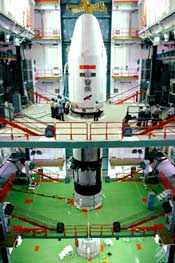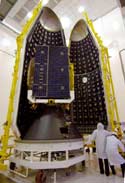Team ISRO bounces back with a thrilling GSLV launch; INSAT 4CR in orbit
By Venkatachari Jagannathan | 03 Sep 2007
 Sriharikota:
At 6:20 pm on a cloudy Sunday evening, the 49-metre high Indian geosynchronous
satellite launch vehicle F04 (GSLV) weighing 414 tonne blasted-off the second
launch pad at the Satish Dhawan Space Centre in Sriharikota.
Sriharikota:
At 6:20 pm on a cloudy Sunday evening, the 49-metre high Indian geosynchronous
satellite launch vehicle F04 (GSLV) weighing 414 tonne blasted-off the second
launch pad at the Satish Dhawan Space Centre in Sriharikota.
With a majestic
roar that reverberated throughout the space port like a roll of thunder, the Rs160crore
GSLV F04 made its historic first and final flight into orbit carrying the communications
satellite INSAT 4CR.
It is for the first time that an INSAT 4 series satellite was successfully launched by an Indian rocket from Indian soil with the previous two - INSAT 4A and INSAT 4B - being launched on board the European Ariane launch vehicle The Rs150-crore satellite, the heaviest to be launched by an Indian rocket so far, weighed 2,130kg.
While the cost of the vehicle was Rs160 crore ($40 million), the satellite cost Rs150 crore ($37 million). What remains unexplained is the Rs54-crore cost increase in making the satellite in a matter of one year. INSAT 4CR is said to be the replica of INSAT 4C that was destroyed in July last year (See: ISRO forced to destroy GSLV in mid air). At that time it was said INSAT 4C cost ISRO Rs96 crore.
The first stage, GS1, comprises a core motor with 138 tonnes of solid propellant and four strap-on motors each with 42 tonnes of hypergolic liquid propellants (UH25 and N2O4).
The second stage (GS2) has 39 tonnes of the same hypergolic liquid propellants. The third stage (GS3) is a cryogenic stage with 12.6 tonnes of Liquid Oxygen (LOX) and Liquid Hydrogen (LH2). The aluminium alloy GSLV payload fairing is 3.4 m in diameter and is 7.8 m long.
Be
that as it may, with a rich orange flame at its rear the rocket left behind a
huge tail of white fume ascended towards the blue sky amidst the resounding cheers
of Indian Space Research Organisation''s (ISRO) scientists and media team assembled
at the launch centre.
 Seventeen
minutes into the flight, 5,000 kilometres away from the launch pad and over Indonesia,
the rocket slung INSAT 4CR into geosynchronous transfer orbit (GTO).
Seventeen
minutes into the flight, 5,000 kilometres away from the launch pad and over Indonesia,
the rocket slung INSAT 4CR into geosynchronous transfer orbit (GTO).
The
satellite will be manoeuvered to its 36,000 km-high geosynchronous orbit (GSO)
by firing its onboard liquid apogee motor (LAM) in subsequent days. It will have
a mission life of 11 years. The satellite has 1,189 kg of mono methyl hydrazine
(MMH) as fuel and mixed oxides of nitrogen as oxidiser.
The payloads are
12 Ku-band 36 MHz bandwidth transponders employing 140 W TWTAs to provide effective
isotropic radiated power of 51.5 dBW at the edge of its coverage, with a footprint
covering entire Indian mainland and the Ku-band beacon as an aid to track the
satellite. With this, India has 212 transponders in the sky.
The satellites 12 Ku-band 36 MHz bandwidth transponders will be used for providing direct-to-home television services, digital news gathering and also service the VSAT users.
The successful launch has given ISRO the needed confidence to target the global market for launching heavier satellites.
"We are hopeful of achieving 5-10 per cent market share over next five years," declares G Madhavan Nair, chairman, ISRO confidently.
According to Nair, ISRO''s launch rates would be cheaper that what is charged by others in the market. "We can carry heavy satellites (weighing 4 tonnes) 40 per cent cheaper and the smaller satellites (1 tonne) at 20 per cent lower rates than what others are charging now," he declared.
"We are getting a lot of enquiries for GSLV Mark III that can carry heavy satellites," added K R Sridharamurthi, executive director, Antrix Corporation, the marketing arm of ISRO. The improved version that can carry 4-tonne payloads is currently under development.
Not a cursed project but a dramatic launch
Given the bad omens prior to the launch, it was thought the launch of the GSLV carrying the INSAT satellite was a cursed project.
A few days ago ISRO lost two of its senior officials in a road accident as they were were travelling to Tirupathi to seek the blessings of Lord Venkateswara for a successful GSLV launch. This had brought a pall of gloom prior to the rocket''s launch.
Secondly the launch which was originally scheduled for 1 September, but had to be postponed to Sunday evening at 4.21 pm owing to bad weather.
And
on the day of launch, 15 seconds before the lift-off, the rocket''s computers put
GSLV on hold detecting anomalies in the cryogenic fuel stage. In case of launches
the computers take over the checking of the systems 12 minutes before the lift-off.
The
launch was postponed by two hours to set right the problem even as ISRO officials
were considering rescheduling the launch by another two days.
However, the detection of one of the vent valves in the cryogenic engine that had not shut properly led to its immediate rectification, said Nair.
Incidentally, a similar fault had occurred in the GSLV''s maiden flight in 2001 and the rocket was unnot able to develop sufficient thrust to sling its payload into the intended orbit.
In July 2006 when ISRO launched GSLV F02 carrying INSAT 4C, the lift-off was delayed by 1.38 hours owing to a fault. Soon after the lift-off, ISRO had to destroy the rocket mid air as it careened off its path owing to a faulty strap-on motor.
Yesterday, the suspense didn''t end with the rocket''s lift-off. The ISRO scientists were on tenterhooks till the last moment. For a few seconds during the final cryogenic stage signals from the rocket failed to reach the the ground stations.
"Our hearts stopped for a few seconds. Fortunately, the signals came alive soon. It is a dramatic launch," said Nair.
According
to Dr B N Suresh, director, director, Vikram Sarabhai Space Centre, ISRO, "The
success of the mission has proved GSLV as a robust and dependable rocket."
INSAT 4CR in good health
Soon after its injection into intermediate
orbit, the two solar arrays were automatically deployed. The satellite is monitored
by the ground station of ISRO Telemetry, Tracking and Command network (ISTRAC)
located in the Indonesian island, Biak. The master control facility at Hassan
in Karnataka has taken control of the satellite for all its post-launch operations.
Ground stations at Lake Cowichan (Canada), Fucino (Italy) and Beijing (China)
are supporting ISRO''s Hassan facility in monitoring and orbit raising activities.
The
satellite will be collocated with other Indian satellites Kalpana-1, INSAT 3C
and Edusat.
The INSAT 4CR is the third satellite in the INSAT 4 series.
The first two INSAT 4A and 4B were launched in 2005 and 2006 by European Ariane
launch vehicle. The third satellite INSAT 4C launch mission in July 2006 was a
failure.





















